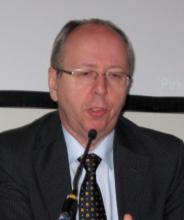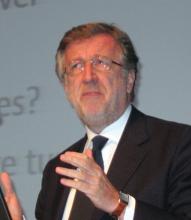AMSTERDAM – Quantifying the amount of epidermal growth factor receptor in a patient’s advanced nonsmall cell lung cancer tumor appeared to identify the tumors that best responded to treatment with cetuximab in an analysis of 1,125 patients enrolled in a key multicenter treatment trial.
The analysis was a follow-up to the positive Cetuximab Plus Chemotherapy in Patients with Non–Small Cell Lung Cancer (FLEX) study, which showed a benefit from the addition of cetuximab (Erbitux) to platinum-based therapy (Lancet 2009;373:1525-31).
Division of the study population into 31% with a high level of epidermal growth factor receptor (EGFR) expression on the surface of tumor cells and 69% with lower expression identified a patient subgroup, the high expressors, that responded best to cetuximab with no increased toxicity, Dr. Robert Pirker reported at the World Conference on Lung Cancer, sponsored by the International Association for the Study of Lung Cancer.
"The data clearly show that EGFR is a predictive biomarker because in high-EGFR cancers cetuximab changed survival, reduced the hazard ratio to 0.73 [compared with patients not getting cetuximab], but in patients with lower EGFR, cetuximab added nothing to survival," said Dr. Pirker, professor and program director for lung cancer at the Medical University of Vienna.
"We increase efficacy without increasing toxicity, improving the benefit-to-risk ratio. This is a major step forward toward personalized medicine, especially for patients with high EGFR, about a third of patients with advanced disease," he said.
Because the FLEX study’s prespecified goals included analysis of the link between EGFR density and cetuximab response, the new findings warrant immediate application to practice, according to Dr. Pirker. "I believe this is such a significant improvement in survival that we’ve never seen before that we should be able to provide it to our patients," he said.
Future work should examine the potential role of other drugs that affect EGFR activity (the tyrosine kinase inhibitors such as erlotinib and gefitinib) and also the potential role of cetuximab in high EGFR expressors with earlier-stage lung cancer, he added.
But while other lung cancer specialists saw this finding as an exciting new opportunity for directing EGFR-based treatment to the patients who stand to benefit most, they also called for caution in using EGFR quantification in routine practice.
"It needs prospective validation before it can be standard of care," commented Dr. Roy S. Herbst, chief of medical oncology at the Yale Cancer Center in New Haven, Conn. "It’s very intriguing and makes sense that the amount of receptor will make a difference for cetuximab, but it needs to be tested prospectively because they determined the cutoff retrospectively. It’s always dangerous to use a cutoff determined post hoc, because it becomes a self-fulfilling prophesy. It needs to be studied in a validation set. But it gives new hope for the potential use" of cetuximab and other drugs aimed at EGFR function, Dr. Herbst said in an interview.
"These findings from a post hoc analysis for the selected cutoff are extremely interesting and important, but it needs prospective validation," agreed Dr. Giorgio V. Scagliotti, professor of respiratory medicine at the University of Torino, Italy.
The EGFR scoring formula that Dr. Pirker and his associates developed used a commercially available immunohistochemistry staining kit, made by DAKO. Scoring involved rating the staining intensity of each stained cell in a tumor specimen on a scale of 0-3, where 0 is no staining and 3 is the highest level of staining, and then multiplying each score level by the percent of cells in the specimen with that score. This results in a potential score range of 0 (100% of cells have a score of 0) to 300 (100% of cells have a score of 3).
In their review of the FLEX data, the researchers found that 345 (31%) of patients had tumors with a score of at least 200, the cutoff they selected post hoc for a high level of EGFR expression, and the other 776 (69%) had a low score, less than 200.
With this method distinguishing tumors with high and low levels of EGFR expression, the 345 patients in the high category had a 0.73 hazard ratio for mortality when treated with cetuximab plus chemotherapy (cisplatin plus vinorelbine), compared with patients treated with chemotherapy only (P = .011). This appeared to improve on the reduced mortality seen with cetuximab treatment in the entire study of 1,125 patients, which produced a hazard ratio of 0.87 (P = .044). In the 776 patients with lower EGFR expression, the addition of cetuximab led to no change in survival compared with patients who received the control treatment regimen.




